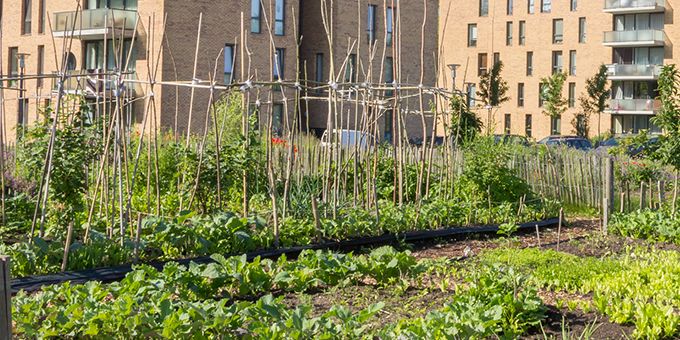Here’s a guide to help you understand what urban gardening entails and why it is the key to meeting growing demand while helping urban consumers and communities exercise control over the way their food is grown.
 Urban Gardening-The Next Step to Bring Greenery Back in the Concrete Jungle.
Urban Gardening-The Next Step to Bring Greenery Back in the Concrete Jungle.

Article from | Organica Biotech
Introduction
According to FAO reports, by 2050, more than 6 billion people will reside in urban areas, almost twice the current population of 3.5 billion. 55% of the world’s population already lives in urban areas, where 80% of food produced will be consumed in urban areas.
In India, reports by the UN state that 40.76% of the country’s population will live in urban areas by the year 2030. The rural production system will burden the increasing demand for fruits and vegetables in urban markets. But there is one solution that can combat rapid urbanization, food shortage and climate change all at once – urban gardening. Here’s a guide to help you understand what urban gardening entails and why it is the key to meeting growing demand while helping urban consumers and communities exercise control over the way their food is grown.
What is Urban Gardening?
Urban gardening is cultivating and processing food in and around urban localities. Urban gardening also involves animal husbandry, aquaculture, beekeeping and horticulture. Essentially, it is a conventional crop growing in a city setting. With urbanization and the desire of more people to do their farming where they live, urban gardening has become a popular and effective option – a departure from the conventional belief that crop production can only be done in rural areas. The rapid growth of the city population in the developing region is placing enormous demands on food supply systems, leading to food shortages during the crisis. Urban gardening can help resolve this crisis. The minimal land available in this concrete jungle is utilized for gardening.
Types of Urban Gardens
Let us understand some types of Urban Gardening that could benefit individuals and help them sustain themselves independently.
Kitchen Gardening:
It is small-scale cultivation where herbs and spices are grown in a small piece of land or even pots for daily kitchen use. Kitchen Gardening is mainly done to meet a small family’s everyday needs and becomes less dependent on the market availability.
Tactical Gardening:
This entails making the most of the limited land available to perform agriculture without spending much money. For example, a city inhabitant may easily create a keyhole garden to cover an area on the street intended for car parking. This uses land that would otherwise go to waste and instead makes an activity that may be enjoyed or used to produce other food.
Street landscaping:
This prepares streets for various uses, such as resident’s community gardens. They beautify the streets, purify the air, resulting in a healthy environment. They benefit from minimizing urban stormwater runoff because they are primarily positioned along the road.
Vertical farming:
Vertical farms may entail farming higher up to lessen the agricultural land footprint. Green walls are a good option for vertical farms because they take up a small area and may be done on the sides of vertical walls. Vertical farming can be done in tall apartments, abandoned old buildings and also on walls.
Types of crops to grow in Urban Gardens
Vegetables have a short production cycle. They are harvested within 60 days of planting, making them fit for urban gardening. Some of the major crops cultivated in urban gardening are leafy Vegetables or herbs like spinach, coriander, curry leaves, mint leaves etc. and other vegetables like tomato, capsicum, chillies, peas, french beans, etc.
After understanding the types and crops cultivated in urban gardening, we need to understand the pros and cons. Every coin has two sides, and so does urban gardening.
Advantages of Urban Gardening
Nutritional & Quality Food: By growing your crops, you can ensure the food’s quality will be excellent if no chemical fertilizers are used during cultivation. Hence, making it safe to consume.
Boost food security:
As the world’s population grows and arable land is depleted, urban gardening improves the land area used for agriculture, enhancing food security.
Economic benefits:
Urban gardening can help a city’s economy grow by generating economic activity by producing, packing, and selling food, vegetable, herb, and fruit products. A dynamic and hardworking community translates into people who can contribute to the economy.
Disadvantages of Urban Gardening
Lacks awareness: Urban gardening is not recognised in agricultural policies and urban planning, thus ignoring its importance in the system.
Health risks: It carries health and environmental hazards – potential use of contaminated land and water and inappropriate pesticides and fertilizers can leak into water sources.
Other factors: Urban farms face an additional challenge in managing rodents, pests and weeds, and sudden climate change.
Sometimes, plants are too dependent on fertilizers and other chemicals for their growth. How practical would urban gardening be from other farms by injecting or spraying chemicals?
The right way to practice Urban Gardening
While setting up the urban garden, one must follow good practices such as-
Choosing the right location: Look for a place where the urbanites can grow maximum crops in the confined area. Ensure there is plenty of sunlight coming in so that the plants can stay healthy.
Choosing a suitable growth medium: Usually, an urban garden is set up in pots or large trays to grow leafy vegetables. Ensure there are holes for water to pass through.
Use of fertilizers: Manure and fertilizer help maintain and produce crops. Chemical fertilizers can be avoided as it causes bioaccumulation. Organica Biotech provides eco-friendly chemical-free products to help the plant increase its nutritional value.
MagicGro Plant Care is crafted for urban gardening purposes. It is a natural soil revitalizer made with probiotic microbes that boost plant’s immunity and growth. It improves nutrient uptake, leaf and flower pigmentation, making them brighter in colour.
Magic Gro Plant Care also protects plants against diseases like mold formation, wilting, scabs, blotches, rots, etc. With this revolutionary product, maintaining your urban garden becomes easy.
With this increasing population, it is crucial to become self-sufficient and ease the burden on rural food production. Urban Gardening is gaining importance in today’s world. Many urban farms are created for educational purposes, to train the school kids and young professionals and help them understand the importance of agriculture. Apart from benefiting the environment, it also plays a role in maintaining health. It is restoring greenery in the concrete jungle and at the same time providing nutrition to humans.
The content & opinions in this article are the author’s and do not necessarily represent the views of AgriTechTomorrow
Comments (0)
This post does not have any comments. Be the first to leave a comment below.
Featured Product

